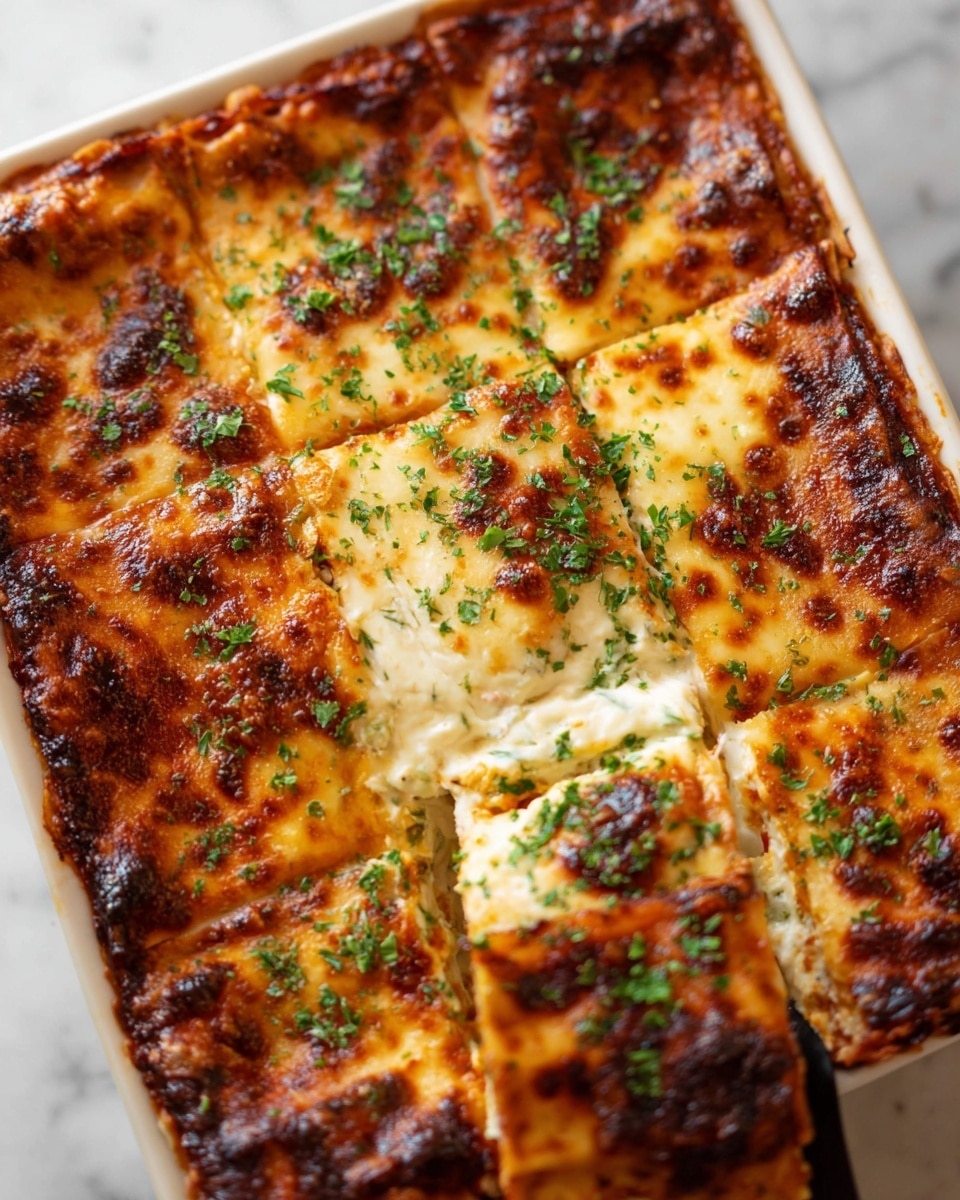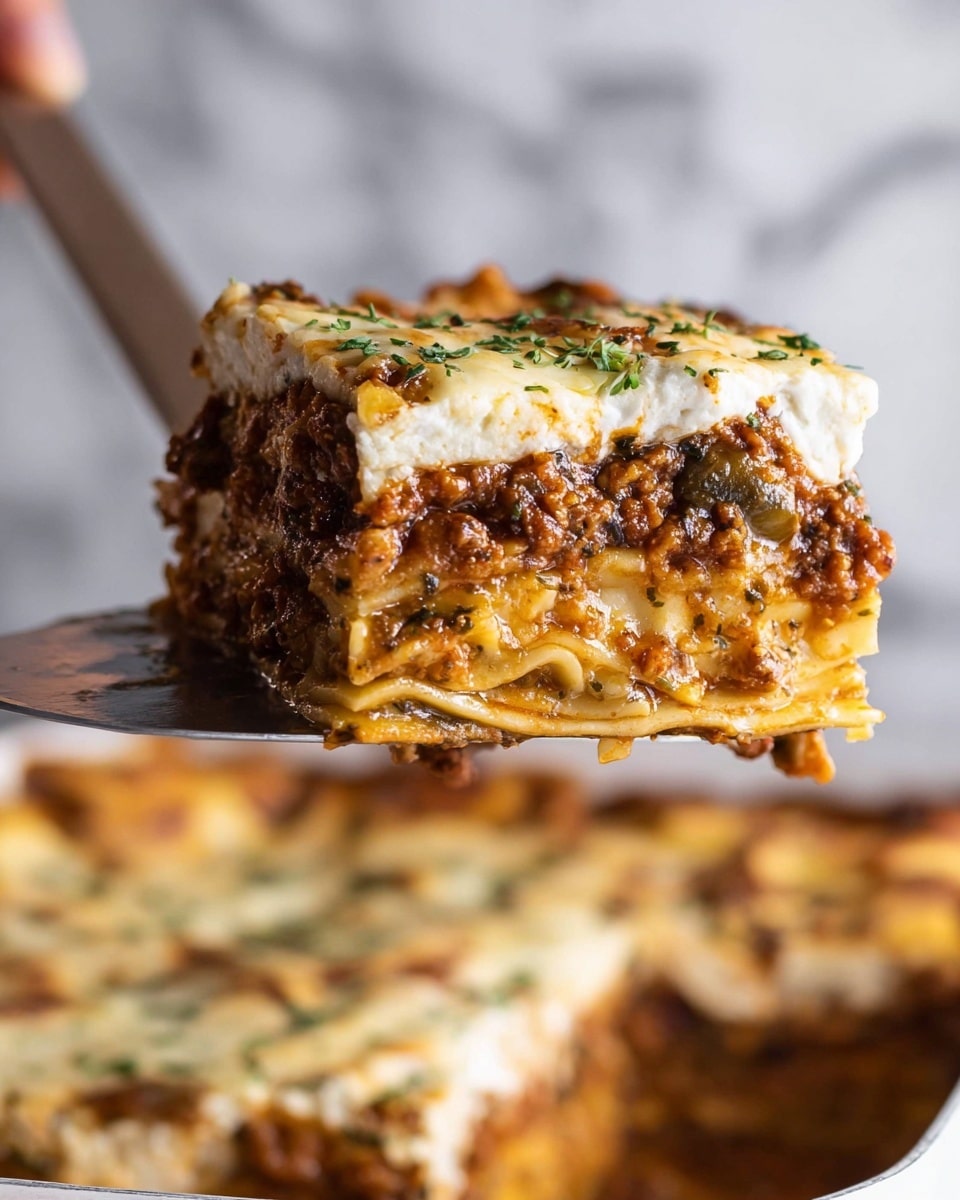I absolutely love this Outrageously Delicious Greek Moussaka Recipe because it captures the heart of traditional Greek comfort food with layers of perfectly cooked veggies, rich beef, and that silky béchamel topping. When I first tried making this, I was amazed at how the blend of spices and textures came together for a dish that’s both hearty and elegant. It’s perfect for family dinners or whenever you want to impress guests with something that feels special but is totally doable in your own kitchen.
You’ll find that this recipe works well for making ahead or feeding a crowd since it reheats beautifully and keeps all its richness intact. What makes it worth trying is how the deep, savory meat sauce contrasts with the tender, fried eggplants and creamy béchamel, creating unforgettable layers of flavor and comfort. Trust me, once you taste it, you’ll want to make it again and again!
Why You’ll Love This Recipe
- Authentic Flavors: A classic Greek recipe that brings traditional herbs and spices together for a truly rich taste.
- Layered Goodness: Perfect balance between tender veggies, meaty sauce, and creamy béchamel that satisfy every bite.
- Great for Entertaining: Make ahead friendly and ideal for feeding a crowd or a comforting family meal.
- Learnable Technique: Step-by-step instructions help you master frying, saucing, and assembling even if it’s your first time.
Ingredients You’ll Need
This Outrageously Delicious Greek Moussaka Recipe uses familiar ingredients that when combined create magic, but I’ll share my favorite tips to get the best quality out of each one as we go along.
- Olive Oil: Use a good quality extra virgin olive oil for the best flavor and healthier cooking.
- White Onion: Finely diced for that perfect savory sweetness that melts into the beef sauce.
- Garlic: Fresh and finely diced for subtle but essential aromatic depth.
- Ground/Minced Beef: I prefer lean ground beef to avoid excess grease but still keep it juicy.
- Tomato Paste: It adds a rich, concentrated tomato flavor that brightens the meat sauce.
- Dry Red Wine: Definitely adds complexity but you can substitute with beef stock if you want.
- Tomato Passata: Smooth pureed tomatoes give the sauce that perfect, fresh tomato base.
- Beef Stock: Adds depth and keeps the sauce hearty without extra fat.
- Fresh Parsley: Chopped finely to sprinkle in layers and garnish for fresh color and flavor.
- Fresh Thyme Leaves: For that subtle herbaceous note that’s classic in Greek dishes.
- Bay Leaf: Adds warmth and depth while the sauce simmers.
- Salt, Sugar, Cinnamon, Black Pepper: Balances savory, sweet, and spice perfectly.
- Unsalted Butter and Plain Flour: These two make the base for the luscious béchamel sauce.
- Milk: Room temperature milk whisked in slowly to create a smooth, creamy béchamel.
- Nutmeg and White Pepper: Classic spices for that unmistakable béchamel flavor.
- Pecorino Romano: Freshly grated for sharp, salty flavor both in sauce and sprinkled.
- Egg Yolks: Whisked into béchamel to add richness and silkiness.
- Vegetable or Olive Oil: For frying the veggies — adequate quantity needed to gently shallow fry.
- Baking Potatoes: Peeled and sliced thinly, the foundational bottom layer for texture and heartiness.
- Zucchini/Courgettes: Sliced lengthwise to cook evenly and add a tender, light layer.
- Eggplants/Aubergine: Fried until tender and golden for that signature moussaka texture — well salted to draw out bitterness.
- Parsley & Pecorino: Sprinkled between layers for bursts of flavor.
- Salt & Pepper: Adjusted to taste throughout for perfect seasoning.
Variations
I love trying variations on this Outrageously Delicious Greek Moussaka Recipe depending on what’s in season or to suit dietary needs. Feel free to adapt the vegetables, protein, or spices to make it your own!
- Vegetarian Variation: Swap the ground beef with lentils or a mix of mushrooms and walnuts for a meaty texture without the meat — it’s surprisingly satisfying!
- Lower Fat Option: Instead of frying the veg, try brushing them with olive oil and roasting in the oven. I’ve done this when short on time, and it still tastes fantastic.
- Herb Twists: Adding a bit of fresh oregano or dill in place of thyme gives a slightly different but equally authentic Greek touch.
- Spice It Up: For a bit of color and warmth, sprinkle a pinch of smoked paprika into your meat sauce — it adds a subtle smoky depth.
How to Make Outrageously Delicious Greek Moussaka Recipe
Step 1: Building a Rich Flavorful Beef Sauce
Heat your olive oil over medium heat and gently soften the diced onions until golden and sweet, which takes about 7-8 minutes—don’t rush this step as it builds your flavor base. Next, add the minced garlic and cook for another minute until fragrant. Toss in the ground beef and break it apart with your spoon, cooking until fully browned. Stir in the tomato paste and let it cook out for a couple of minutes to deepen the flavor. Pour in the red wine to deglaze the pan, scraping up any delicious browned bits. Add the passata and beef stock along with parsley, thyme, cinnamon, salt, sugar, pepper, and bay leaf. Let everything simmer gently for around 30 minutes, stirring occasionally until the sauce is thickened and irresistible. Trust me, this layer will make your moussaka sing!
Step 2: Prepping and Salting the Veggies
Lay some paper towels flat and layer your veggies carefully to draw out excess moisture—a trick I picked up that keeps your layers from becoming soggy. You’ll start with your eggplant slices laid on a paper towel, season lightly with salt, add two fresh paper towels, then the zucchini on top with another paper towel, and finally the potato slices capped with a last paper towel. Gently press down to soak as much water as possible—this step is important for good texture later on.
Step 3: Frying the Vegetables to Golden Perfection
Heat enough oil in a large pan so the vegetables will be gently frying but not sizzling aggressively—aim for around 150°C/300°F for the potatoes first. Fry each slice until they’re a lovely light golden and tender, then drain on fresh paper towels to soak up the oil. Increase the oil temperature slightly to about 170°C/340°F and do the same with the zucchini and then the eggplant, ensuring each vegetable is cooked properly but not greasy. This frying step brings that incredible richness and soft texture that makes this moussaka so memorable.
Step 4: Making the Silky Béchamel Sauce
Melt your butter over medium heat and whisk in the flour to form a smooth roux; cook for a minute or two but don’t let it brown. Slowly pour in your room-temperature milk while whisking constantly to avoid lumps—and be patient here! Keep cooking until the sauce thickens so it can coat the back of a spoon (the perfect consistency every time). Season with salt, white pepper, and freshly grated nutmeg. Remove from heat and stir in your grated Pecorino Romano until it melts smoothly. Finally, whisk in the egg yolks quickly to add richness and a silky texture. I always save half a cup of this sauce to stir into the beef mixture—this step binds everything together beautifully.
Step 5: Layering the Moussaka for Ultimate Comfort
Start with a layer of your perfectly fried potato slices at the bottom of your dish, overlapping a bit and sprinkling generously with parsley, pecorino, and seasoning. Next comes the zucchini layer, again sprinkled lightly with herbs, cheese, salt, and pepper. Add half the eggplant slices with seasoning, pressing everything close together for a firm stack. Spread the rich beef sauce evenly over this vegetable base, then add the remaining eggplant slices on top. Finally, pour your creamy béchamel over the whole dish, smoothing it out and topping with a sprinkle more of pecorino. This is where the magic happens as it bakes into a golden masterpiece.
Step 6: Baking and Serving the Outrageously Delicious Greek Moussaka Recipe
Pop your assembled moussaka into a preheated oven at 180°C/350°F for 35 to 45 minutes until the top turns golden and just lightly charred in spots. Resist the urge to dig in right away—I’m serious! Let it rest for at least 15 minutes to firm up so you get those beautiful slices instead of a messy scoop. Serve hot, garnished with a sprinkle of fresh parsley, and watch how everyone’s eyes light up with the first bite.
Pro Tips for Making Outrageously Delicious Greek Moussaka Recipe
- Salting Eggplant: I discovered this trick when I salted my eggplants in layers – it really removes bitterness and prevents sogginess.
- Oil Temperature Control: Fried veggies taste best when the oil’s temperature is just right, so use a thermometer or test with a small slice first.
- Béchamel Consistency: When making the béchamel, patience is key—whisk slowly and cook until thick to avoid lumps and achieve that signature creamy texture.
- Rest After Baking: Avoid cutting immediately—letting it rest helps to keep the layers intact and makes serving much easier.
How to Serve Outrageously Delicious Greek Moussaka Recipe

Garnishes
I always garnish my moussaka with a sprinkle of freshly chopped parsley and a little extra Pecorino Romano grated over the top right after it’s out of the oven. It adds a fresh pop of color and a slightly salty, cheesy bite that complements the rich dish beautifully.
Side Dishes
My favorite side is a simple Greek salad with cucumbers, tomatoes, red onion, olives, and feta dressed in red wine vinaigrette. Garlic bread or warm pita also pairs wonderfully to scoop up any leftovers on your plate.
Creative Ways to Present
For special occasions, I’ve layered individual portions in small ramekins and baked them separately—it’s a fun way to serve guests and looks impressive. You could also try topping with a sprinkle of toasted pine nuts for crunch or drizzle with a drizzle of good olive oil for a glossy finishing touch.
Make Ahead and Storage
Storing Leftovers
I store leftover moussaka covered tightly in the fridge for up to 3 days. It actually tastes better the next day once the flavors have had time to meld together even more. I find slicing into neat portions before storing makes reheating easier and cleaner.
Freezing
This recipe freezes really well! Just assemble in a freezer-safe container and freeze before baking, or freeze leftovers in portions. When freezing before baking, thaw overnight in the fridge and then bake as usual. This saves so much time on busy nights.
Reheating
I reheat leftovers in a 350°F (180°C) oven, covered loosely with foil to prevent drying out, for about 20-25 minutes. This helps maintain the creamy béchamel texture and crisps the top slightly again. Microwave works in a pinch but doesn’t deliver the same texture.
FAQs
-
Can I make this Outrageously Delicious Greek Moussaka Recipe ahead of time?
Absolutely! You can prepare the layers and even assemble the moussaka a day ahead. Just cover it tightly and refrigerate. Then bake fresh when ready for a fantastic meal with minimal last-minute effort.
-
What can I substitute for red wine in the beef sauce?
If you prefer to skip alcohol, using beef stock or a mix of red grape juice and balsamic vinegar works well without sacrificing depth of flavor.
-
How do I prevent the eggplant from becoming soggy?
Salting and draining the eggplant slices before frying is a game changer, as it pulls out moisture and reduces bitterness. Also, frying at the right oil temperature helps them stay tender but not greasy.
-
Can I make a vegetarian version of this Outrageously Delicious Greek Moussaka Recipe?
Yes, swapping the ground beef with cooked lentils, mushrooms, or even textured vegetable protein can recreate the hearty texture while keeping it meat-free.
Final Thoughts
This Outrageously Delicious Greek Moussaka Recipe holds a special place in my heart because it’s more than just a meal—it’s a celebration of layers, textures, and deeply comforting flavors. Whether you’re making it for family Sunday dinner or that get-together where you want to wow your guests, I promise this dish will bring smiles and full plates. Give it a try and enjoy every bite—you might just find your new favorite go-to Greek classic!
Print
Outrageously Delicious Greek Moussaka Recipe
- Prep Time: 40 minutes
- Cook Time: 70 minutes
- Total Time: 110 minutes
- Yield: 8 servings
- Category: Main Course
- Method: Baking
- Cuisine: Greek
Description
This classic Greek Moussaka recipe features layers of tender fried potatoes, zucchini, and eggplants, topped with a rich, aromatic beef tomato sauce and a creamy, cheesy béchamel topping. Slow simmered for deep flavor and baked to golden perfection, it’s a hearty, comforting dish that truly embodies Mediterranean home cooking.
Ingredients
Beef Sauce Layer
- 1 tbsp Olive Oil
- 1 large White Onion, finely diced
- 2 cloves Garlic, finely diced
- 1.6lb / 750g Ground/Minced Beef (preferably fairly lean)
- 2 heaped tbsp Tomato Paste
- 1/2 cup / 120ml Dry Red Wine (or beef stock substitute)
- 1 cup / 240ml Tomato Passata
- 1 cup / 240ml Beef Stock
- 1/4 cup finely diced Fresh Parsley, plus extra to serve
- 1 tbsp finely diced Fresh Thyme Leaves
- 2 small or 1 large Bay Leaf
- 3/4 tsp Salt, or to taste
- 1/2 tsp Sugar
- 1/2 tsp Cinnamon
- 1/4 tsp Black Pepper, or to taste
Vegetable Layer
- 2lb / 1kg Eggplants/Aubergine (approx 4 smallish), sliced
- 1lb / 500g Zucchini/Courgettes (approx 2 medium), sliced lengthwise into approx 1/3″ strips
- 1.6lb / 750g Baking Potatoes (approx 2 large), peeled and sliced about 1/4″ thick
- 2 cups / 480ml Vegetable or Olive Oil (for frying)
- Salt & Pepper, as needed
- Few pinches of Parsley & Pecorino for sprinkling between layers
Béchamel Sauce
- 4oz / 120g Unsalted Butter
- 4oz / 120g Plain Flour
- 4 cups / 1 litre Milk (at room temperature)
- 1/2 tsp Salt, or to taste
- 1/4 tsp White Pepper
- 1/2 small Nutmeg, grated or 1/4 tsp ground nutmeg
- 1 cup / 80g freshly grated Pecorino Romano
- 2 Egg Yolks
Instructions
- Prepare the Beef Layer: Heat 1 tbsp olive oil in a large pan over medium heat. Add diced onion and fry until soft and golden, then add garlic and fry for another minute. Add ground beef, cook and break up with a spoon until browned. Stir in tomato paste and cook for 2 minutes. Deglaze with red wine, then add tomato passata and beef stock. Season with parsley, thyme, cinnamon, salt, sugar, black pepper, and bay leaf. Simmer gently for about 30 minutes until thickened, stirring occasionally.
- Prepare the Vegetables: Layer eggplant slices on paper towels, sprinkle both sides with salt, then cover with two paper towels. Repeat layering with zucchini slices, paper towels, and then potato slices topped with paper towels. Press gently to remove excess moisture.
- Fry the Vegetables: Heat enough oil in a pan to cover the vegetables to around 150°C (300°F). Fry potato slices until lightly golden and tender, remove and drain on paper towels. Increase oil temperature to 170°C (340°F) and fry zucchini slices until softened and lightly browned. Then fry eggplant slices similarly. Drain all vegetables well on paper towels to remove excess oil.
- Make the Béchamel Sauce: Melt butter in a pot over medium heat. Stir in flour to form a roux, cook briefly. Gradually whisk in room temperature milk to avoid lumps. Simmer until thick enough to coat the back of a spoon. Remove from heat, add salt, white pepper, nutmeg, and grated Pecorino Romano. Stir until smooth. Quickly whisk in egg yolks. Reserve 1/2 cup of sauce to stir into the beef mixture.
- Assemble the Moussaka: Spread a layer of potato slices in the baking dish, sprinkle with parsley, Pecorino, salt, and pepper. Add a layer of zucchini with the same seasonings, then half the eggplant with salt and pepper. Press layers to be compact and fill gaps. Spread the beef layer over the eggplant, top with remaining eggplant slices, then cover evenly with the béchamel sauce.
- Bake and Serve: Sprinkle Pecorino on top and bake in a preheated oven at 180°C (350°F) for 35–45 minutes, until the top is golden and lightly charred. Let the moussaka rest for at least 15 minutes before serving to set and keep its shape. Garnish with extra parsley and serve warm.
Notes
- Using paper towels to press and dry the vegetables is crucial to prevent sogginess and excessive oil absorption.
- Temperature control when frying vegetables is important: lower heat for potatoes, higher for zucchini and eggplant to get the best texture without burning.
- To speed up the cooking process, you can use two pans for frying vegetables or alternatively bake one or two of the vegetable layers.
- Letting the moussaka rest after baking helps it hold its shape when sliced.
- This recipe yields about 8 servings, perfect for family dinners or meal prepping.
- Ensure the béchamel sauce is thick enough to coat the spoon for a creamy and stable top layer.
Nutrition
- Serving Size: 1 serving
- Calories: 571 kcal
- Sugar: 14.52 g
- Sodium: 746 mg
- Fat: 29.22 g
- Saturated Fat: 12.344 g
- Unsaturated Fat: 14.811 g
- Trans Fat: 0.427 g
- Carbohydrates: 42.95 g
- Fiber: 6.2 g
- Protein: 34.11 g
- Cholesterol: 141 mg









